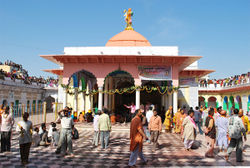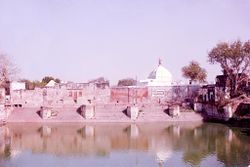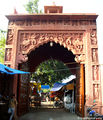Baldeo
Introduction | Index | Marvels | Books | People | Establishments | Freedom Fighter | Image Gallery | Video
This website is under construction please visit our Hindi website "HI.BRAJDISCOVERY.ORG"
Baldeo / Baldev / बलदेव
|
Introduction |
MATHURA A GAZETTEER,
edited and compiled by, D.L. DRAKE-BROCKMAN [1911]
The town of Baldeo lies in 27°24'N. and 77°49'E., on the road from Muttra to Sadabad, at a distance of 10 miles from Muttra and some 5 miles from Mahaban. The place is familiarly called Dauji and is generally known by that name among villagers. The original village was called Rirha and still exists, but only as a mean suburb occupied by the labouring classes; the total area is returned at 458 acres. Baldeo contains a police station, sub-post-office, primary school attended by over 100 boys, and cattle-pound; while a short distance away on the Sadabad road is an inspection bungalow maintained by the district board. The town has been administered since 1859 under Act XX of 1856. Income is raised by the usual house-tax and averages some Rs. 1,500 per annum. It is expended in the maintenance of some town police, a small staff of sweepers for conservancy, and simple improvements. The population has increased of late years, for in 1881 it numbered 2,835 persons. This rose to 3,253 in 1891, and at the last enumeration in 1901, the inhabitants were returned at 3,367 souls, of whom 3,148 were Hindus and 141 were Musalmans. The prevailing Hindu castes are Jats, Banias and Brahmans.

The town derives all its celebrity from the famous temple of Balaram or Baladev, Krishna's elder brother. This is about 150 years old, but, despite its popularity among Hindus, it is neither handsome nor well-appointed. The temple itself, built by Seth Shiam Das of Delhi, stands at the back of one inner court, and on each of its three disengaged sides has an arcade of three bays with broad flanking piers. On each of these three sides a door gives access to the calla, which is surmounted by a squat pyramidal tower. In addition to the principal figure, Baladeva, who is generally very richly dressed and bedizened with jewels, it contains another life-sized statue, supposed to represent his spouse, Revati. In an adjoining court is shown the small vaulted chamber which served the god as a residence for the first century after his epiphany. The precincts of the temple include as many as eleven cloistered quadrangles, where accommodation is provided for pilgrims and the resident priests. Each court, or kunj as it is called, bears the name of its founder as follows:—the Kunj of Rashk Lal of Agra and Lucknow, 1817 A.D.; of Bachharaj, Bania, of Hathras, 1825; of Nawal Karan, Bania, of Agra, 1768; of Bhim Sen and Hulas Rai, Banias, of Muttra, 1828; of Das Mal, Khattri, of Agra, 1801; of Bhattacharya of Jaipur, 1794; of Gopal, Brahman, of Jaipur; of Chiman Lal, of Muttra, 1778; of Jadu Ram, Khattri, of Agra, 1768; of Chunna, Halwai, of Bharatpur, 1808; and of Puran Chand, Pachauri, of Mahavan, 1801.
Adjoining the temple is a brick built tank, over 80 yards square, called variously Kshir Sagar, the "Sea of Milk," Kshir Kund, or Balbhadra Kund. It is in a dilapidated condition, and the surface of the water is always covered with a thick green scum which, however, does not deter the pilgrims either from drinking or bathing in it. Here it is said that Gosain Gokul Nath was warned in a vision that a god lay concealed. Immediate search was made, and the statue of Baladeva, that has ever since been regarded as the tutelary divinity of the place, was revealed to the adoring gaze of the assembled multitude. Attempts were made to remove it to Gokul; but as every cart broke down, either from the weight of the stone or the reluctance of the god to change his abode, a shrine was erected for his reception on the spot, and an Ahivasi of Bhartiya, by name Kalyan, was con stituted guardian. From his two sons Jamuna Das and Musiya or Sukadeva are descended the Pandes who now manage the temple. They have acquired considerable landed property, besides the old village of Rirha. This brings in a substantial income but forms only a small part of their wealth, for the offer ings at the shrine in the course of the year are estimated to yield a net profit of about Rs. 30,000. The Kshir Sagar and all the fees paid by pilgrims bathing in it belong not to the temple Pandes, but to a community of Sanadh Brahmans. The temple Pandes, however, assert rights to the tank, and there is a standing quarrel between the two parties which has caused some litigation. Near the tank is a shrine dedicated by Bihari Lai, Bohra, of Mursan, in 1803 to the honour of the god Harideva, and two stone chhatris in memory of the Pandes, Harideva and Jagannath. Two annual fairs are held at Baldeo, one on the sixth day of the light half of Bhadon, commonly called Deo Chath, the other on the full moon of Aghan; but there is probably not a single day in the course of the whole year in which the temple courts are not occupied by at least one hundred pilgrims, drawn from all parts of northern India. A charitable dole of one anna apiece is given to every applicant. The Pandes and their families have now multiplied exceedingly, and the annual cost of their mainten ance must be considerable. Ordinarily there is a division of the profits among the shareholders at the end of every three months: an allotment is made into twelve portions, that being the number of the principal subdivisions of the clan, and then each subdivision makes, a separate distribution among its own members.
The Village Sanitation Act (United Provinces Act II of 1892) is in force in the town.
MATHURA A DISTRICT MEMOIR By F.S. Growse [ D.M. Mathura-1874 ]

Some six miles beyond Maha-ban, a little to the right of the high road lead ing to Sadabad and Jalesar, is the famous temple of Baladeva, in the centre of a modern town with a population of 2,835, which also bears the same name. The original village was called Rirha, and still exists, but only as a mean suburb occupied by the labouring classes. Adjoining the temple is a brick-built tank, above 80 yards square, called variously Kshir Sagar, the ‘sea of milk,’ or Kshir Kund, or Balbhadra Kund. It is in a dilapidated condition, and the surface of the water is always covered with a repulsive thick green scum, which, however, does not deter the pilgrims either from drinking or bathing in it. Here it is said that Gosain Gokulnath was warned in a vision that a god lay concealed. Immediate search was made, and the statue of Baladeva, that has ever since been regarded as the tutelary divinity of the place, was revealed to the adoring gaze of the assembled multitude. Attempts were made to remove it to Gokul; but as every cart broke down, either from the weight of the stone, or the reluc tance of the God to change his abode, a shrine was erected for his reception on the spot, and an Ahivasi of Bhartiya, by name Kalyan, constituted guardian. From his two sons, Jamuna Das and Musiya, or Sukadeva, are descended the whole horde of Pandas, who now find the God a very valuable property. They have acquired, by purchase from the Jats, the old village of Rirha (read note 9) , and are also considerable landowners in six other villages—viz., Artoni, Nera, Chhibarau, Kharaira, Nur-pur and Shahab-pur, whence they derive an annual income of Rs. 3,853. This estate, which was for the most part a grant from Sindhia, forms, however, but a small part of their wealth, as the offerings made at the shrine in the course of the year are estimated to yield a net profit of Rs. 30,000 more. The Kshir-Sugar and all the fees paid by pilgrims bathing in it belong not to the temple Pandas, but to a community of Sanadh Brahmans.
The temple, despite its popularity, is neither handsome nor well appointed. Its precincts include as many as eleven cloistered quadrangles, where accomdation it provided for the pilgrims and resident priests. No definite charge is levied on the former, but they are expected to make a voluntary donation to their means. Each court, or kunj, as it is called, bears the name acoording of its founder as follows:—1st, the Kunj of Rashk Lad of Agra and Lakhnan, 1817 A, D.; 2nd, of Bachharaj, Baniya, of Hathras, 1825; 3rd, of Naval Karan, Baniya, of Agra, 1868; 4th, of Bhim Sen and Hulas Rai, Baniyas, of Mathura, 1828; 5th, of Das Mal, Khattri, of Agra, 1801; 6th of Bhattacharya of Jaypur, 1794; 7th of Gopal, Brahman, of Jaypur; 8th of Chiman Lal, of Mathura, 1778; 9th, of Sada Ram, Khattri, of Agra, 1768; 10th, of Chunna, Halwai, of Barat-pur, 1808; and 11th, of Puran Chand, Pachauri, of Maha-ban, 1801. The actual temple, built by Seth Syam Das, of Delhi, towards the end of last century,: stands at the back of one of the inner courts, and on each of its three disengaged sides has an arcade of three bays with broad flanking piers. On each of these three sides a door gives access to the cella, which is surmounted by a squat pyramidal tower. In addition to the principal figure, Baladeva ,who is generally very richly dressed and bedizened, with jewels, it contains another life sized statue, supposed to represent his spouse Revati. Apparently she was an after thought, as she is put away in a corner, off the dais. In an adjoining court shown the small vaulted chamber which served the God as a residence for the century after his epiphany. Near the tank is a shrine dedicated by Bihari lal, Bohra, of Mursan, in 1803, to the honour of the god Harideva, and two stone chhatris in memory of the Pandas, Harideva and Jagannath.
Two annual melas are held at Baladeva, the one Bhadon sudi 6th (commonly called Deo Chath), the other on the full moon of Agahn; but there is probably not a single day in the course of the whole year in which the temple courts are not occupied by at least as many as a hundred pilgrims, who come from all parts of Northern India. The cost of the religious ceremonial cannot be much, but a charitable dole of an ana apiece is given to every applicant; and as the Parades with their families now number between 300 and 400 persons, the annual cost of their maintenance must be very considerable. After reasonable deduc tions on these three heads—viz., temple expenses, charity, and maintenance of the priests, the balance of profits is calculated at over Rs. 30,000. There is ordinarily a division among the shareholders at the end of every three months, when they make an allotment into twelve equal portions, that being the num ber of the principal sub-divisions of the clan, and then each sub-division makes a separate distribution among its own members. The votive offerings in the vast majority of cases are individually of very trifling amount; but even so, their collective value is not altogether to be despised. Thus, poorer pilgrims, in addition to a few copper coins, often present a piece of sugar; and the heap of sugar accumulated in three or four days has been sold by auction for as much as Rs. 80. The shrine is a very popular one among all classes; scarcely ever is an important venture made without a vow that the God shall receive a fixed share of the profits, if he bring it to a successful issue; and even casual votaries, who have no special boon to beg, are often most lavish in their donations, either of money, horned cattle, carriages, horses, or other property. For example, a few years ago, Surajbhan, a wealthy merchant of Agra, gave Rs. 4,000 worth of jewellery for the personal adornment of the God.
It is unfortunate that the hereditary guardians of so wealthy a shrine should be such a low and thriftless set as the Ahivasis are. The temple-garden occupies 52 bighas of land and was once a well-planted grove. It is now a dirty, unsightly waste, as the Panties have gradually cut down all the trees for firewood, without a thought of replacing them. They have thus not only dete riorated the value of their property, but also forfeited a grant that used to be made by the Maharaja of Bharat-pur for its maintenance. It is also asserted to be a common practice for the younger members of the clan, when they see any devotees prostrate in devotion before the god, to be very forward in assisting them to rise and leading them away, and to take the opportunity of despoiling them of any loose cash or valuable ornaments that they can lay their hands upon. It is believed that thefts of this kind are frequent; though the victim generally prefers to accept the loss in silence, rather than incure the odium of bringing a charge, that there might not be legal evidence to substantiate, against a professedly religious community. It appears in every way desirable that some extra police should be maintained at the expense of the Pandes, and a constable or two kept permanently on duty in the inner court of the temple. As an illustration of the esteem in which learning is held in this large and wealthy Brahmanical town, it may be mentioned that the school is not only merely a primary one, but is also about the smallest and worst of its class in the whole district.
Gallery
Entry Gate, Dauji Temple, Baldev, Mathura


